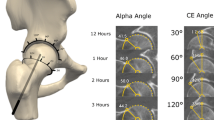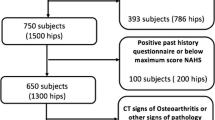Abstract
The concept of femoroacetabular impingement (FAI) proposes the development of hip osteoarthritis through motion-induced damage to the acetabular cartilage and labrum. Thus, dynamic interaction of the proximal femur and acetabulum is the crux of FAI. Several types of FAI can be distinguished, but FAI classification is mostly done with separate parameters for acetabular and femoral morphology on planar images, without direct representation of the femoroacetabular interaction. Five main parameters influence impingement between the proximal femur and the acetabular rim: alpha and center edge angles, acetabular and femoral version, and neck-shaft angle. We attempted to integrate these five parameters in order to reflect their interaction and derive a signal comprehensive parameter, the omega surface, to characterize the severity of FAI. The omega surface is a CT-based delineation of the femoral head surface that represents the area for impingement-free motion. The omega surface is determined with dedicated software (Articulis™) and can be determined for various positions of the hip joint. We determined the omega surface in a pilot study for five different hip morphotypes and found the omega surface was smaller in FAI morphotypes than in a normal hip. Furthermore, the omega surface was smaller in symptomatic versus control subjects with FAI morphotypes. The omega surface may therefore help in improved differentiation between symptomatic and asymptomatic FAI hips.





Similar content being viewed by others
References
Arbabi E, Chegini S, Boulic R, Tannast M, Ferguson SJ, Thalmann D (2010) Penetration depth method—novel real-time strategy for evaluating femoroacetabular impingement. J Orthop Res 28(7):880–886
Audenaert EA, Peeters I, Vigneron L, Baelde N, Pattyn C (2012) Hip morphological characteristics and range of internal rotation in femoroacetabular impingement. Am J Sports Med 40(6):1329–1336
Bardakos NV, Villar RN (2009) Predictors of progression of osteoarthritis in femoroacetabular impingement: a radiological study with a minimum of ten years follow-up. J Bone Joint Surg Br 91(2):162–169
Beck M (2011) Letter to the editor: cams and pincer impingement are distinct, not mixed: the acetabular pathomorphology of femoroacetabular impingement. Clin Orthop Relat Res 469(4):1207 author reply 1208-9
Beck M, Kalhor M, Leunig M, Ganz R (2005) Hip morphology influences the pattern of damage to the acetabular cartilage: femoroacetabular impingement as a cause of early osteoarthritis of the hip. J Bone Joint Surg Br 87(7):1012–1018
Cobb J, Logishetty K, Davda K, Iranpour F (2010) Cams and pincer impingement are distinct, not mixed: the acetabular pathomorphology of femoroacetabular impingement. Clin Orthop Relat Res 468(8):2143–2151
Elson RA, Aspinall GR (2008) Measurement of hip range of flexion-extension and straight-leg raising. Clin Orthop Relat Res 466(2):281–286
Ganz R, Parvizi J, Beck M, Leunig M, Notzli H, Siebenrock KA (2003) Femoroacetabular impingement: a cause for osteoarthritis of the hip. Clin Orthop Relat Res 417:112–120
Ganz R, Leunig M, Leunig-Ganz K, Harris WH (2008) The etiology of osteoarthritis of the hip: an integrated mechanical concept. Clin Orthop Relat Res 466(2):264–272
Hack K, Di Primio G, Rakhra K, Beaule PE (2010) Prevalence of cam-type femoroacetabular impingement morphology in asymptomatic volunteers. J Bone Joint Surg Am 92(14):2436–2444
Hogervorst T, Bouma HW, de Vos J (2009) Evolution of the hip and pelvis. Acta Orthop 80(336):1–39
Ito K, Minka MA 2nd, Leunig M, Werlen S, Ganz R (2001) Femoroacetabular impingement and the cam-effect. A MRI-based quantitative anatomical study of the femoral head-neck offset. J Bone Joint Surg Br 83(2):171–176
Krekel PR, de Bruin PW, Valstar ER, Post FH, Rozing PM, Botha CP (2009) Evaluation of bone impingement prediction in pre-operative planning for shoulder arthroplasty. Proc Inst Mech Eng H 223(7):813–822
Milone MT, Bedi A, Poultsides L, Magennis E, Byrd JW, Larson CM, Kelly BT (2013) Novel CT-based three-dimensional software improves the characterization of cam morphology. Clin Orthop Relat Res 471(8):2484–2491
Notzli HP, Wyss TF, Stoecklin CH, Schmid MR, Treiber K, Hodler J (2002) The contour of the femoral head-neck junction as a predictor for the risk of anterior impingement. J Bone Joint Surg Br 84(4):556–560
Nötzli HP, Wyss TF, Stoecklin CH, Schmid MR, Treiber K, Hodler J (2002) The contour of the femoral head-neck junction as a predictor for the risk of anterior impingement. J Bone Joint Surg Br 84(4):556–560
Sun H, Inaoka H, Fukuoka Y, Masuda T, Ishida A, Morita S (2007) Range of motion measurement of an artificial hip joint using CT images. Med Biol Eng Comput 45(12):1229–1235
Turley GA, Williams MA, Wellings RM, Griffin DR (2013) Evaluation of range of motion restriction within the hip joint. Med Biol Eng Comput 51(4):467–477
Weisstein EW (2013) Dot product. MathWorld: a wolfram web resource. http://mathworld.wolfram.com/DotProduct.html
Weisstein EW (2013) Spherical coordinates. MathWorld: a wolfram web resource http://mathworld.wolfram.com/SphericalCoordinates.html
Wiberg G (1953) Shelf operation in congenital dysplasia of the acetabulum and in subluxation and dislocation of the hip. J Bone Joint Surg Am 35-A(1):65–80
Wu G, Siegler S, Allard P, Kirtley C, Leardini A, Rosenbaum D, Whittle M, D’Lima DD, Cristofolini L, Witte H, Schmid O, Stokes I (2002) ISB recommendation on definitions of joint coordinate system of various joints for the reporting of human joint motion—part I: ankle, hip, and spine. J Biomech 35(4):543–548
Wyss TF, Clark JM, Weishaupt D, Notzli HP (2007) Correlation between internal rotation and bony anatomy in the hip. Clin Orthop Relat Res 460:152–158
Acknowledgments
We thank Peter Krekel (Clinical Graphics, Delft, The Netherlands) for technical assistance and suggestions and Erik Boekestein for his ICC measurements.
Author information
Authors and Affiliations
Corresponding author
Rights and permissions
About this article
Cite this article
Bouma, H., Hogervorst, T., Audenaert, E. et al. Combining femoral and acetabular parameters in femoroacetabular impingement: the omega surface. Med Biol Eng Comput 53, 1239–1246 (2015). https://doi.org/10.1007/s11517-015-1392-6
Received:
Accepted:
Published:
Issue Date:
DOI: https://doi.org/10.1007/s11517-015-1392-6




